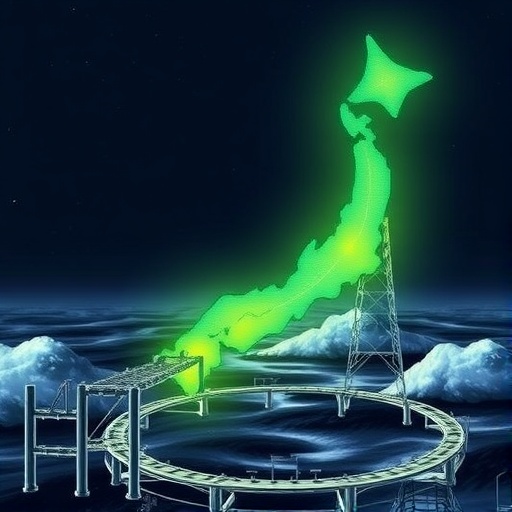Since the catastrophic nuclear accident at the Fukushima Daiichi Nuclear Power Station in March 2011, tremendous efforts have aimed at controlling the leakage of radioactive contaminants into the surrounding environment. Despite vigorous countermeasures undertaken by Tokyo Electric Power Company Holdings (TEPCO), the inadvertent release of radioactive isotopes such as cesium-137 (^137Cs) into the adjacent ocean persists at low but concerning levels. Notably, fluctuations in ^137Cs concentrations in the seawater inside the nuclear plant’s harbor have been continuously observed, manifesting as seasonal increases during summer, decreases in winter, and sharp spikes following rainfall events. These puzzling patterns have posed significant challenges in understanding the precise mechanisms governing radioactive discharge pathways from the site to the ocean.
In a groundbreaking investigation, researchers from the University of Tsukuba have ingeniously employed tritium (³H) as a natural hydrological tracer to unravel the complexities of ^137Cs transport mechanisms around Fukushima Daiichi. Tritium, a radioactive isotope of hydrogen, had leaked from storage tanks during the 2013-2014 period and, critically, shares similar hydraulic behavior with water itself. Using this leaked tritium as a marker enabled scientists to track the detailed pathways through which radioactive cesium migrates from the nuclear facility into the coastal environment, particularly focusing on discharge via the so-called K drainage channel whose outlet was redirected toward the harbor in 2015.
The study revealed a hitherto underappreciated route underlying the contamination flow: rainwater falling onto the rooftops of reactor buildings—termed “roof drainage”—collects radioactive cesium deposited on surfaces and then flows through gutters directly into the K drainage channel. This roof drainage constitutes the dominant source of ^137Cs discharge into the harbor, accounting for more than half (53%) of the annual radioactive cesium outflow during the monitoring period from 2016 to 2021. Complementary pathways include rainwater surface runoff contributing around 31%, and a baseflow component linked to groundwater influx comprising approximately 15%. This baseflow varies in response to air temperature, with heightened ^137Cs levels observed in summer, suggesting seasonal dynamics influencing groundwater contamination.
Importantly, these insights challenge prior assumptions that groundwater seepage solely controlled radioactive cesium discharge patterns, underscoring the critical role of atmospheric precipitation interacting with infrastructure surfaces in contaminant mobilization. The combination of hydrological tracing and isotope monitoring has thus enabled a detailed quantitative partitioning of the multiple contributors fueling seasonal fluctuations in harbor radioactivity. This enhanced mechanistic understanding provides a foundational framework to refine environmental surveillance, optimize remediation strategy designs, and bolster efforts to minimize ongoing radionuclide leaks into marine ecosystems near Fukushima.
Beyond its immediate implications for Fukushima Daiichi’s environmental management, this innovative methodology carries broad applicability for nuclear facilities worldwide. By leveraging naturally occurring or accidental radiotracer releases such as tritium, researchers can non-invasively dissect complex contaminant flow networks and identify critical source terms with high precision. Such capability is indispensable for surveillance during decommissioning processes and for designing robust safeguards against radionuclide dispersal following nuclear incidents—tasks of growing importance as the global community advances nuclear energy systems.
The quantitative spotlight on roof drainage as a chief vector for ^137Cs highlights infrastructure surfaces as a crucial interface controlling radionuclide mobilization. This knowledge invites engineering interventions focused on capturing or diverting contaminated rainwater at building eaves and gutters before entry into drainage channels, which could substantially decrease radioactive discharges. Furthermore, understanding seasonal hydrological variations permits adaptive management approaches, anticipating periods of elevated risk such as the summer season when groundwater-derived baseflow intensifies contamination levels.
Moreover, the ability to discern multiple overlapping discharge pathways using radiotracer techniques reinforces the value of integrative environmental monitoring, combining hydrology, radiation chemistry, and isotopic analyses. This holistic view confronts the multifaceted nature of radionuclide transport, accounting for atmospheric inputs, surface runoff, structural contributions, and groundwater dynamics in a coherent framework. Such comprehensive assessments inform policymakers and regulatory bodies tasked with enforcing environmental safety standards in nuclear energy contexts.
The use of tritium as a tracer also exemplifies cutting-edge scientific innovation in environmental radioactivity studies. Despite its own radioactive characteristics, tritium’s behavior as a conservative hydrological tracer—meaning it moves with water without significant chemical interactions—makes it uniquely suited for delineating waterborne contaminant pathways. Exploiting leaked tritium, once deemed solely a contamination hazard, as a valuable investigative tool represents a paradigm shift enhancing both environmental science and radiation safety research.
Considering that the Fukushima Daiichi Nuclear Power Station remains a vital case study more than a decade after the accident, the findings from this research contribute to the evolving legacy of nuclear safety and environmental stewardship. They remind us that radioactive contamination is not a static issue but a dynamic one influenced by weather, infrastructure configurations, and subsurface conditions. As such, continuous careful monitoring coupled with sophisticated scientific methodologies remains imperative to protecting marine ecosystems and human health from persistent low-level radioactive releases.
Ultimately, this investigative breakthrough opens doors to more informed interventions and monitoring infrastructures across nuclear sites globally. Employing natural or accidental radiotracers promises more precise characterization of contaminant pathways, enabling targeted mitigation and safeguarding natural water resources more effectively. These advancements bring the scientific community one step closer to mitigating the lingering environmental ramifications of nuclear accidents and improving resilience in future nuclear energy operations.
Subject of Research: Investigation of radioactive cesium (^137Cs) discharge pathways from Fukushima Daiichi Nuclear Power Station to the ocean using tritium (³H) as a hydrological tracer.
Article Title: Leaked tritium reveals the source of ^137Cs from the Fukushima Daiichi Nuclear Power Plant to the ocean.
News Publication Date: August 24, 2025
Web References: DOI: 10.1016/j.watres.2025.124464
Image Credits: Credit to Yuichi Onda, University of Tsukuba; image sourced from “Leaked tritium reveals the source of ^137Cs from the Fukushima Daiichi Nuclear Power Plant to the ocean,” Water Research. Licensed under CC BY 4.0.
Keywords
Water quality, Environmental chemistry, Hydrogeochemistry, Groundwater, Radioisotopes, Surface runoff, Wastewater




